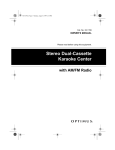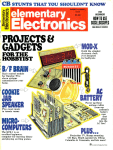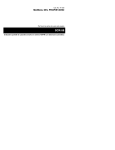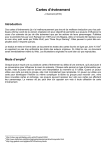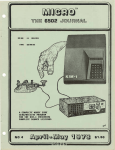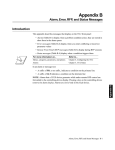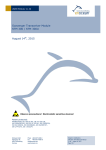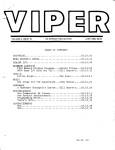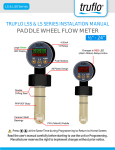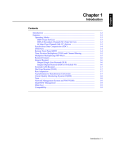Download KIM Hints - Bryan`s Old Computers
Transcript
KIM HINTS Since you and your KIM-1 are relative strangers, we'd like to help you get better acquainted. The material in this pamphlet will answer questions that are frequently asked by a new KIM-1 user. . ANSWERS TO POPULAR KIM SYSTEM QUESTIONS 1. IS IT POSSIBLE TO OUTPUT DIGITS OTHER THAN HEX TO THE 6 OUTPUT LED'S? Since the 6502 is doing all segment decode and multiplex, it is possible to display data other than hex on a 7-segment readout. A pseudo alphabet has been developed and is displayed in the 7-segment display of the KIM in a scrolling manner. 2. WHEN HANDLING THE BOARD, WOULD THE STATIC HAZARD BE R E L I E V E D IF ALL EDGE CONNECTORS WERE SHORTED TOGETHER? The static problems are not as serious once the devices are installed in the P.C. board. Just be sure to use grounded tools and to discharge yourself to ground before touching KIM or the connected circuits. 3. WHAT TYPE OF LED READOUT IS USED ON KIM-1 FOR U18, etc?GENERAL COMMON ANODE OR CATHODE? USE MAN-72 Type displays, available from many manufacturers. General common anodes should work, although you may find intensity differences between them. 4. WHERE CAN I GET MORE 44-PIN EDGE CONNECTORS FOR KIM? The connector is a standard part —you can order a Vector No. R644 from most electronic supply houses. The connector is also carried by most Radio Shack stores as Part No. 276-548. 5. ARE THERE ANY INTERFACES OR PROM PROGRAMMERS AVAILABLE WITH KIM TO PROGRAM EPROMs OR TO DUPLICATE PROMs? No, not yet. 6. IS THERE AN I/O EXPANSION BOARD AVAILABLE? Not yet . . . soon, we hope. 7. IS THERE A BOARD AVAILABLE TO MAKE USE OF MEMORY ADDRESSES 0400-13FF? Check the "Kilobaud" article (issue #4, April 1, 1977, page 74) entitled "KIM Memory Expansion." 8. HOW DO I SET UP MY KIM FOR AUDIO CASSETTE RECORDING AND PLAYBACK? A number of KIM-1 customers have reported difficulty in achieving correct results for the sample problem shown in Sec. 2.4 of the KIM-1 User Manual. In addition, some customers have experienced problems in recording or playback of audio cassettes. (Sec. 2.5 of the KIM-1 User Manual). In all cases, the problems have been traced to a single cause: the inadvertent setting of the DECIMAL MODE. The 6502 Microprocessor Array used in the KIM-1 system is capable of operating in either binary or decimal arithmetic mode. The programmer must be certain that the mode is selected correctly for the program to be executed. Since the system may be in either mode after initial power-on, a specific action is required to insure the selection of the correct mode. Specifically, the results predicted for the sample problem (Sec. 2.4) are based on the assumption that the system is operating in the binary arithmetic mode. To insure that this is the case, insert the following key sequence prior to the key operations shown at the bottom of Page 11 of the KIM-1 User Manual. AD/ This sequence resets the decimal mode flag in the Status Register prior to the execution of the sample program. The same key sequence may be inserted prior to the key operations shown on pages 14 and 15 for audio cassette recording and playback. These operations will not be performed correctly if the decimal mode is in effect. In general, whenever a program is to be executed in response to the /GO/ key, the programmer should insure that the correct arithmetic mode has been set in the status register (OOF1) prior to program execution. HOW DO I SOLVE AUDIO CASSETTE INTERFACE PROBLEMS? A. Insure that memory location OOF1 has been set to a value of 00 before recording or playing back the tape. This is the source of 90% of all cassette problems. B. Mis-adjustment of the variable resistor ( V R 1 ) in the cassette circuitry is almost never a problem. Any setting near the center of its rotation will work fine. C. Make sure that +12V is connected during playback. NOTE: +12V is not required for recording, so a lack of +12V will result in good recording but no playback. D. If the display frequently relights showing FFFF, the fault is probably in the tape unit itself — not the KIM. Using poor quality cassettes is usually to blame. Some cassette recorders have such poor power filtering circuits that they will work fine on batteries, but will not work with an AC adapter because of hum induced during record or playback. Tapes should always be rewound before removal from the machine, as a fingerprint on the tape will result in errors on playback. E. Make sure that only a single ground line is run from the KIM ground to the barrel of the microphone input of the cassette recorder. Leave the barrel of the earphone output ungrounded. The shield around the line to the earphone should be attached to ground on KIM. F. Problems of playing a tape recorded on one KIM system back on another system or a different cassette player can usually be solved by adjusting the head adjustment screw on the new cassette recorder. Play back a cassette recorded on the old deck on the new machine and adjust the head screw on the new machine for maximum volume. This adjustment is especially critical when using the SuperTape program. 10. HOW DO I SOLVE TELETYPE PROBLEMS? A. The most common problem is that the system does not respond to a reset-rubout sequence with a model 33 Teletype. This can be fixed by removing the wire connected to pin R on the KIM application connector, connecting a 470 ohm resistor to that wire, and connecting the other end of the resistor to the +12V supply at pin N. 11. HOW DO I SOLVE PAPER TAPE PROBLEMS? A. KIM-1 's having a date code in 1975 on the 6502 will not read paper tape correctly. These CPU's will be replaced by MOS without charge. Tom Pittman's TINY BASIC will not work on these machines either. The problem occurs because early versions of the processor did not set the zero flag correctly on TXA, TYA, TAX, or TAY instructions. B. When using a Texas Instruments Silent 700 data terminal equipped with digital cassettes or other higherspeed paper tape devices, a Q (paper tape dump) may be performed at any speed acceptable to the data terminal, but playback (through the L command) must be at 10 cps. 12. WHAT DO I DO ABOUT OTHER PROBLEMS? A. If the RESET on KIM causes only a single digit or segment to light on the display, the KIM must be returned for repair. B. When in doubt, check all power supply voltages on the KIM board, not at the power supply terminals. C. When software works strangely or erratically, decimal/binary mode problems may be involved. D. There is an error in the KIM Resident Assembler manual regarding the addresses for the symbol table vectors. The vector locations are DF, EO, E1, E2. The text is incorrect, the example is correct. E. Problems with KIM-2/3's which fail the memory test program can almost always be traced to excessive cable length between the KIM-1 and the KIM-2/3. Any cable should be 6" in length or less. 13. WHAT ARE THE KIM SYSTEM POWER SUPPLY REQUIREMENTS? KIM -> TO + 12 v N KIM 1 — Microcomputer Board: 470 -X- Recommended: TO TELETYPE KEYBOARD B. No information is available on connecting other Teletype models (14, 28, 32) to KIM. C. Schematics for interfacing KIM to an RS232C port are in the April, 1976 "Byte" magazine and in the first issue of the KIM user notes. (Reproduced below): 1.2A +5V ±5% 100mA +12V±5% The actual power measured ranges 700 mA to 1A at +5V and the schematic indicating 3A at transformer is incorrect. KIM 3A-8K RAM Memory Board: Recommended: +5V, 3A Average consumption calculated is about 2.4A. Board has +5V regulator accepting unregulated +8 to +10V DC. KIM 4-Mother Board: Consumption about 200mA. Board has +5V regulator accepting unregulated +8 to + 10V DC and +12V regulator accepting unregulated +15V DC to support both KIM1 and KIM 4. KIM 4 has 6 slots for memory expansion with KIM2 and KIM3 and hence a total power supply requirement is a cumulative value dependent on KIM-System configuration. D. Other common sources of Teletype problems are a short circuit in C5 or a burned-out Q7. Signal tracing with a 'scope should reveal these problems. 14. WHAT SOFTWARE IS AVAILABLE? The following software is available for use with the KIM-1 and/or other 6502-based systems: 1. Tiny BASIC - runs in 2K. $5 for paper tape from: Tom Pittman Box 23189 San Jose, California 95153 8. A 4K version of FOCAL, a BASIC-like interpreter, and a 6K Resident assemble/text Editor, both with source listings and object code on KIM cassette or paper tape are available from: ARESCO 314 Second Ave. Haddon Heights, NJ 08035 The FOCAL is $50 and the assembler/Editor is $70. A complete information package is $2. 2. Many games and other information in the KIM-1 User Group Newsletter, $5 for 6 issues: Eric Rehnke 109 Centre Avenue W. Norriton, PA 19401 9. An 8K version of BASIC for KIM is available for $99 from: Johnson Computing 123 W. Washington St. Medina, Ohio 44256 (215) 725-4568 3. An excellent Chess playing program which runs in 1K. $10 MICRO CHESS 27 Firstbroke Rd. Toronto, CANADA M 4E 2L2 4. A good group of games plus an intermediate-level language called PLEASE for KIM-1 - $15 from: 10. "FIRST BOOK OF KIM" is a collection of games, utility programs, hints and kinks, etc. (180 pgs). $9.00 plus 50d postage from: ORB P.O. Box 311 Argonne, ILL 60439 THECOMPUTERIST Post Office Box 3 S. Chelmsford, MA 01824 5. The 6502 Program Exchange 2920 Moana Reno, NV 89509 6. Micro Software Specialists 2024 Washington Street Commerce, TX 75428 INTERVAL TIMER OPERATION 7. KIMATH, a complete floating-point math package including both source and object code is available from MOS Technology for $15. a. Loading the timer The divide rate and interrupt option enable/disable are programmed by decoding the least significant address bits. 1. OPERATION KIM SUBROUTINES The starting count for the timer is determined by the value written to that address. Writing to Address Sets Divide Ratio To Interrupt Capability Is 1704 1705 1706 1707 170C 1 8 64 1024 1 Disabled Disabled Disabled Disabled Enabled b. 170D 8 Enabled 170E 170F 64 1024 Enabled Enabled Determining the timer status 2. CAPABILITIES The KIM Interval Timer allows the user to specify a preset count and a clock divide rate by writing to a memory location. As soon as the write occurs, counting at the specified rate begins. The timer counts down at the clock frequency divided by the divide rate. The current timer count may be read at any time. At the user's option the timer may be programmed to generate an interrupt when the counter counts down past zero. When a count of zero is passed, the divide rate is automatically set to 1 and the counter continues to count down at the clock rate starting at a count of FF (-1 in two's complement arithmetic). This allows the user to determine how many clock cycles have passed since the timer reached a count of zero. Since the counter never stops, continued counting down will reach 00 again then FF, and the count will continue. After timing has begun, reading address location 1707 will provide the timer status. If the counter has passed the count of zero, bit 7 will be set to 1, otherwise, bit 7 (and all other bits in location 1707) will be zero. This allows a program to "watch" location 1707 and determine when the timer has timed out. Note that reading 1707 provides an entirely different function from writing the same location. c. Reading the count in the timer If the timer has not counted past zero, reading location 1706 will provide the current timer count and disable the interrupt option; reading location 170E will provide the current timer count and enable the interrupt option. Thus the interrupt option can be changed while the timer is counting down. Note that you read 1706 or 170E regardless of which location (1704-OF) was written to start the timer. If the timer has counted past zero, reading either memory location 1706 or 170E will restore the divide ratio to its previously programmed value, disable the interrupt option and leave the timer with its current count. d. Using the interrupt option In order to use the interrupt option described above, line PB7 (application connector, pin 15) should be connected to either the IRQ (Expansion Connector, pin 4) or NMI (Expansion Connector, pin 6) pin depending on the desired interrupt function. PB7 should be programmed as an input line (it's normal state after a RESET). NOTE If the programmer desires to use PB7 as a normal I/O line, the programmer is responsible for disabling the timer interrupt option Iby writing or reading address 1706) so that it does not interfere with normal operation of PB7. Also, PB7 was designed to be wire-ORed with other possible interrupt sources; if this is not desired, a 5.1 K resistor should be used as a pull-up from PB7 to +5v. (The pull-up should NOT be used if PB7 is connected to NMI or IRQ.) 3. INTERVAL TIMER AND KEYBOARD OPERATION The following three programs show the use of the interval timer, keyboard and seven segment displays in user programs. The first program loads a value of 50 in the timer and waits for it to time out, repeats the process and then increments the count in the display register (OOFA and OOFB) and calls the display subroutine SCANS. The process then repeats. The second program performs the same function as the first, but uses the timer to provide interrupts, rather than watching the timer status register (1707). Thus this program is constantly cycling through the display program SCANS except when the timer generates an interrupt. When an interrupt occurs the interrupt service routine (starting at location 010C) resets the timer, increments the display register and returns to the display program. Note that the LED display is brighter when using this program because most of the computer's time is spent displaying rather than watching the timer. The third example program demonstrates the use of the keyboard and display. Any key depressed will appear in the rightmost digit of the display and will be shifted to the left with each successive keyboard entry. Notice that the SCANS routine not only displays the contents of OOF9, OOFA and OOFB but also returns with the Z flag set to 0 if a key is currently depressed. The GET- KEY routine is then called to determine which key has been depressed. Since the SCANS subroutine takes several milliseconds, a call to this routine can be used to "waste time" and let any keybounce stop.







